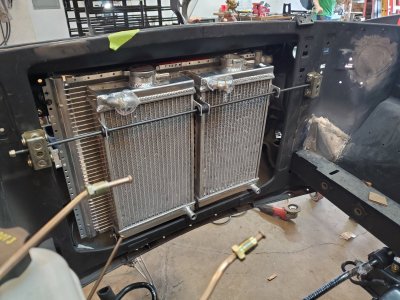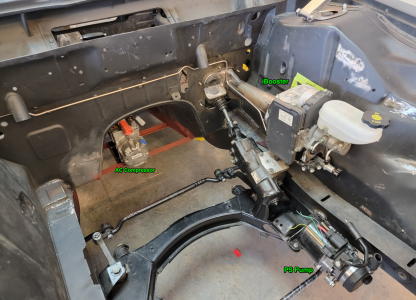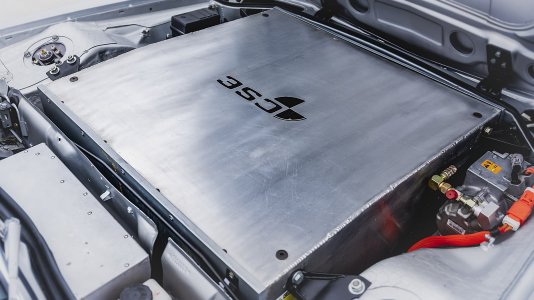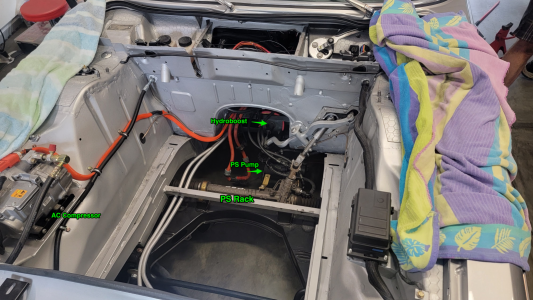Awesome.
You are using an out of date browser. It may not display this or other websites correctly.
You should upgrade or use an alternative browser.
You should upgrade or use an alternative browser.
1974 BMW CSE
- Thread starter JetDexter
- Start date
-
- Tags
- restoration list
Finally. 3 years and 20 pages of build thread later... the CSE is finished.
I finalized the HVAC, glovebox, and dash today. I'm working on a sizzle video but here's a sneak peek at the custom instrumentation (Sorry for the AC/DC. Temp is normal -- I show "most relevant" temp, i.e. closest to max. Just got done charging, thus full fuel gauge, so batteries were a tad warm at 73% of max. Unlike a ICE w/ a thermostat, temp moves linearly so even 90% is nothing to worry about, although it looks odd given what we're used to)...

The interior is a tad rough but it's a driver.

And it drives like a dream.
I finalized the HVAC, glovebox, and dash today. I'm working on a sizzle video but here's a sneak peek at the custom instrumentation (Sorry for the AC/DC. Temp is normal -- I show "most relevant" temp, i.e. closest to max. Just got done charging, thus full fuel gauge, so batteries were a tad warm at 73% of max. Unlike a ICE w/ a thermostat, temp moves linearly so even 90% is nothing to worry about, although it looks odd given what we're used to)...
The interior is a tad rough but it's a driver.
And it drives like a dream.
What an incredible achievement, Jeff! You and Paul have truly created a beautiful monster. I have enjoyed reading everyone of these posts, and I am constantly in awe of what you have done. Congratulations is not enough of a word!
Did a photoshoot with Royce Rumsey.



Beautiful!
Big changes, small changes ( door locks, side marker lights, windshield nozzle cleaner things on the hood). Let me look again for other subtile items.
Love it!
RP
Big changes, small changes ( door locks, side marker lights, windshield nozzle cleaner things on the hood). Let me look again for other subtile items.
Love it!
RP
Seats are from a …?Beautiful!
Big changes, small changes ( door locks, side marker lights, windshield nozzle cleaner things on the hood). Let me look again for other subtile items.
Love it!
RP
Seats are BMW E93 (2004-2013) M3 Convertible (so that the belts are integral). Steering column is BMW E46 (1997-2006 3 Series). Wheels are BMW E39 (1995-2004).

Last edited:
Seats are BMW E93 (2004-2013) M3 Convertible (so that the belts are integral). Steering column is BMW E46 (1997-2006 3 Series). Wheels are BMW E46 330 (2000-2006).
View attachment 162959
I love the way your car turned out! Pretty sure the wheels are Style 32s (staggered 17x8&9s) off a late 90s e39 540.
BMW CCA "BMW Takes Flight" event today at Lyon Air Museum. Set cruise control to 75 and had an easy trip down, a bit more traffic up, but a great day. Thanks to Kyle van Hoften, the museum docents, and all the others who organized it. Got rockstar spots and met some interesting people. Everyone so nice. Only one other e9, lots of 2002s. Photos by Royce Rumsey.




Oh man, flanked by two M1s... Can't ask for better wing motors
Finished the highlights video.
Amazing work Jeff!
Lest anyone thing it's all rainbows and unicorns in the EV conversion world...
Last week the car let me down for the first time in the entire build. Until now, regardless of all the small problems that have arisen, the car had never failed to drive under its own power but I had to tow it home the other day. A sudden reduction in voltage and a variety of faults from the BMS.
I pulled the battery box and discovered that I've had a number of small coolant leaks for some time now. Not enough to see anything on the ground, given that the box is fairly watertight, but enough that the bottom two batteries were sitting in small puddles and encountered a surprising amount of corrosion. But even that wasn't the real problem. Eventually a drop of coolant (G48 for EVs, mixed 50/50 with distilled water -- is still conductive) fell into one of the cell tap connectors and caused a short.
Kudos to Tesla for building very resilient batteries. Despite all this abuse they never fully gave up or caught fire. A few of the small fuse wires blew and the BMS knew enough to shut things down so overall it could've been a lot worse. I am still surprised that the constant tension spring clamps over the tubing and barbed fittings leaked but a pressure test confirmed that the clamps did not provide a complete seal, even though the system is never under much pressure.
New hoses, clamps, and some batteries are on order. I think I'll take this opportunity to make it better/faster while I'm at it, increasing the power and range by taking two of the older batteries into the trunk for a total of 16, and 394v vs the previous 14 and 345v.
It's all part of the fun, right?




Last week the car let me down for the first time in the entire build. Until now, regardless of all the small problems that have arisen, the car had never failed to drive under its own power but I had to tow it home the other day. A sudden reduction in voltage and a variety of faults from the BMS.
I pulled the battery box and discovered that I've had a number of small coolant leaks for some time now. Not enough to see anything on the ground, given that the box is fairly watertight, but enough that the bottom two batteries were sitting in small puddles and encountered a surprising amount of corrosion. But even that wasn't the real problem. Eventually a drop of coolant (G48 for EVs, mixed 50/50 with distilled water -- is still conductive) fell into one of the cell tap connectors and caused a short.
Kudos to Tesla for building very resilient batteries. Despite all this abuse they never fully gave up or caught fire. A few of the small fuse wires blew and the BMS knew enough to shut things down so overall it could've been a lot worse. I am still surprised that the constant tension spring clamps over the tubing and barbed fittings leaked but a pressure test confirmed that the clamps did not provide a complete seal, even though the system is never under much pressure.
New hoses, clamps, and some batteries are on order. I think I'll take this opportunity to make it better/faster while I'm at it, increasing the power and range by taking two of the older batteries into the trunk for a total of 16, and 394v vs the previous 14 and 345v.
It's all part of the fun, right?
Ouch! Glad that you sorted it out!
My car does not have any cooling for tesla batteries, and even when driving longer trips. I did nearly 200km highway and temps were about 37c once I arrived. I only have one cooling loop, which goes through charger and motor. You could just remove the battery cooling loop, if you don't have DC charging or do consecutive quarter mile pulls.
My car does not have any cooling for tesla batteries, and even when driving longer trips. I did nearly 200km highway and temps were about 37c once I arrived. I only have one cooling loop, which goes through charger and motor. You could just remove the battery cooling loop, if you don't have DC charging or do consecutive quarter mile pulls.
Damn. That was a close call! Real glad you caught that one before complete disaster happened
Hello, You have a wonderful car it is one of a kind, I know nothing about electric car and always it was a question for me, how do you make power steering and air conditioning system works what makes a A/C pomp working and do you have a cooling system like gas car or it is just a air cool if you dont mined and have a free time will you just explain concept of A/C heater and power steering brake system is same but other things should be deferent.Damn. That was a close call! Real glad you caught that one before complete disaster happened
thank you in advance
Happy to explain @Candia4441 As I'm sure you can imagine, there are many choices available. And I have made some different choices on the 3 cars I've worked on.
AC is the easiest and most consistent. In all 3 cars I use a Tesla AC Compressor. All other AC components can be the same as a normal ICE car. The Tesla compressor is electric and runs on high voltage (270-400v). Control is via low (12v) voltage and the compressor is variable speed via a PWM signal. It is very nice. Many other electric AC Compressors (such as from a Bolt or Leaf are controlled via CANbus and the message protocols aren't always known).
Cooling has varied from the first car (the one discussed here). This car has just one radiator with one 12v Bosch water pump. Initially (as @mane says) we were able to run it without any battery cooling. The coolant ran through the motor, to the inverter, then to the DC/DC converter, then to the onboard charger, and then back. All those components must be cooled adequately. The motor/inverter will never run at the same time as the OBC so really it is the DC/DC and either the motor/inverter or the OBC.
Even though we didn't experience any abnormally high battery temps, it seemed a bit risky to ignore battery cooling. The Tesla batteries have a built-in coolant loop with thermistors at the inlet and outlet ports built-in. It was too tempting to use that infrastructure and I was concerned that I could get hot spots that the thermistors would not measure if I wasn't averaging out the temp throughout the entire battery module and all cells. Therefore I decided to add the batteries to the system. However, the flow of coolant through the batteries, even though in parallel to all batteries, is quite restricted so the battery loops (there are two, one for the front and another for the trunk) are in parallel with (i.e. teed off of) the other cooled components, which are all in series. Since the coolant takes the path of least resistance, this results in a nominal flow to the batteries but it is enough to at least even out the heat throughout all the cells. Given this latest fiasco, and the fact that residual heat from the big components could be introduced into the batteries via the single cooling system, I have considered going back to no battery cooling.
As a side note, Tesla has very sophisticated temperature management, as you'd expect from an OEM car that can be fast charged. They can introduce heat (from electric heater) or cooling (from AC system) into a heat exchanger that manages the battery loops. Since I don't fast charge, drive in the snow, do track days, or take the car to death valley I can get away with a lot less.
The other cars run two radiators and two electric (12v) water pumps with independent loops for the batteries and the other components. The DC/DC and OBC are also a combined unit in these cars.
As for power steering and power brakes... I've changed approaches with each car. This car uses a VW hydraulic rack and pinion and a Bosch hydroboost brake booster. An electric (12v) power steering pump from a Mini Cooper provides the fluid pressure. This works ok but is a bit noisy and messy.
The second car uses the original power steering gearbox and the same Mini Cooper pump but for power brakes it uses a Telsa (Bosch) iBooster, which is an electric brake booster. This is much cleaner and more compact but the PS still has the noise and complexity of the hydraulic pump. Interestingly, the iBooster is normally controlled via CANbus (it works w/ auto pilot, etc) but we setup it up to run in "failsafe" mode where CAN is irrelevant -- it is activated manually by pressing the brake pedal (image that).
The latest car uses an aftermarket electric (12v) assist rack and pinion rack with the iBooster so it finally does away with all oily fluids and noisy pumps.
Solving all these challenges is much of the fun. It leaves lots of room for creativity.
AC is the easiest and most consistent. In all 3 cars I use a Tesla AC Compressor. All other AC components can be the same as a normal ICE car. The Tesla compressor is electric and runs on high voltage (270-400v). Control is via low (12v) voltage and the compressor is variable speed via a PWM signal. It is very nice. Many other electric AC Compressors (such as from a Bolt or Leaf are controlled via CANbus and the message protocols aren't always known).
Cooling has varied from the first car (the one discussed here). This car has just one radiator with one 12v Bosch water pump. Initially (as @mane says) we were able to run it without any battery cooling. The coolant ran through the motor, to the inverter, then to the DC/DC converter, then to the onboard charger, and then back. All those components must be cooled adequately. The motor/inverter will never run at the same time as the OBC so really it is the DC/DC and either the motor/inverter or the OBC.
Even though we didn't experience any abnormally high battery temps, it seemed a bit risky to ignore battery cooling. The Tesla batteries have a built-in coolant loop with thermistors at the inlet and outlet ports built-in. It was too tempting to use that infrastructure and I was concerned that I could get hot spots that the thermistors would not measure if I wasn't averaging out the temp throughout the entire battery module and all cells. Therefore I decided to add the batteries to the system. However, the flow of coolant through the batteries, even though in parallel to all batteries, is quite restricted so the battery loops (there are two, one for the front and another for the trunk) are in parallel with (i.e. teed off of) the other cooled components, which are all in series. Since the coolant takes the path of least resistance, this results in a nominal flow to the batteries but it is enough to at least even out the heat throughout all the cells. Given this latest fiasco, and the fact that residual heat from the big components could be introduced into the batteries via the single cooling system, I have considered going back to no battery cooling.
As a side note, Tesla has very sophisticated temperature management, as you'd expect from an OEM car that can be fast charged. They can introduce heat (from electric heater) or cooling (from AC system) into a heat exchanger that manages the battery loops. Since I don't fast charge, drive in the snow, do track days, or take the car to death valley I can get away with a lot less.
The other cars run two radiators and two electric (12v) water pumps with independent loops for the batteries and the other components. The DC/DC and OBC are also a combined unit in these cars.
As for power steering and power brakes... I've changed approaches with each car. This car uses a VW hydraulic rack and pinion and a Bosch hydroboost brake booster. An electric (12v) power steering pump from a Mini Cooper provides the fluid pressure. This works ok but is a bit noisy and messy.
The second car uses the original power steering gearbox and the same Mini Cooper pump but for power brakes it uses a Telsa (Bosch) iBooster, which is an electric brake booster. This is much cleaner and more compact but the PS still has the noise and complexity of the hydraulic pump. Interestingly, the iBooster is normally controlled via CANbus (it works w/ auto pilot, etc) but we setup it up to run in "failsafe" mode where CAN is irrelevant -- it is activated manually by pressing the brake pedal (image that).
The latest car uses an aftermarket electric (12v) assist rack and pinion rack with the iBooster so it finally does away with all oily fluids and noisy pumps.
Solving all these challenges is much of the fun. It leaves lots of room for creativity.
Attachments
Hello, thank you very much that you spend all this time explaining how this thing works, you are doing a great job. I am surprise how did you get all this knowledge, and in this case we can use power booster and P/S on the regular gas operating car am I right? but A/C need a high voltage we can not use however it is very interesting project, not only you have to know how it works you have to be able to design how to set this component since this car didn;t made to be electric, you are really a artist, God bless you with your knowledge and beautiful work.Happy to explain @Candia4441 As I'm sure you can imagine, there are many choices available. And I have made some different choices on the 3 cars I've worked on.
AC is the easiest and most consistent. In all 3 cars I use a Tesla AC Compressor. All other AC components can be the same as a normal ICE car. The Tesla compressor is electric and runs on high voltage (270-400v). Control is via low (12v) voltage and the compressor is variable speed via a PWM signal. It is very nice. Many other electric AC Compressors (such as from a Bolt or Leaf are controlled via CANbus and the message protocols aren't always known).
Cooling has varied from the first car (the one discussed here). This car has just one radiator with one 12v Bosch water pump. Initially (as @mane says) we were able to run it without any battery cooling. The coolant ran through the motor, to the inverter, then to the DC/DC converter, then to the onboard charger, and then back. All those components must be cooled adequately. The motor/inverter will never run at the same time as the OBC so really it is the DC/DC and either the motor/inverter or the OBC.
Even though we didn't experience any abnormally high battery temps, it seemed a bit risky to ignore battery cooling. The Tesla batteries have a built-in coolant loop with thermistors at the inlet and outlet ports built-in. It was too tempting to use that infrastructure and I was concerned that I could get hot spots that the thermistors would not measure if I wasn't averaging out the temp throughout the entire battery module and all cells. Therefore I decided to add the batteries to the system. However, the flow of coolant through the batteries, even though in parallel to all batteries, is quite restricted so the battery loops (there are two, one for the front and another for the trunk) are in parallel with (i.e. teed off of) the other cooled components, which are all in series. Since the coolant takes the path of least resistance, this results in a nominal flow to the batteries but it is enough to at least even out the heat throughout all the cells. Given this latest fiasco, and the fact that residual heat from the big components could be introduced into the batteries via the single cooling system, I have considered going back to no battery cooling.
As a side note, Tesla has very sophisticated temperature management, as you'd expect from an OEM car that can be fast charged. They can introduce heat (from electric heater) or cooling (from AC system) into a heat exchanger that manages the battery loops. Since I don't fast charge, drive in the snow, do track days, or take the car to death valley I can get away with a lot less.
The other cars run two radiators and two electric (12v) water pumps with independent loops for the batteries and the other components. The DC/DC and OBC are also a combined unit in these cars.
As for power steering and power brakes... I've changed approaches with each car. This car uses a VW hydraulic rack and pinion and a Bosch hydroboost brake booster. An electric (12v) power steering pump from a Mini Cooper provides the fluid pressure. This works ok but is a bit noisy and messy.
The second car uses the original power steering gearbox and the same Mini Cooper pump but for power brakes it uses a Telsa (Bosch) iBooster, which is an electric brake booster. This is much cleaner and more compact but the PS still has the noise and complexity of the hydraulic pump. Interestingly, the iBooster is normally controlled via CANbus (it works w/ auto pilot, etc) but we setup it up to run in "failsafe" mode where CAN is irrelevant -- it is activated manually by pressing the brake pedal (image that).
The latest car uses an aftermarket electric (12v) assist rack and pinion rack with the iBooster so it finally does away with all oily fluids and noisy pumps.
Solving all these challenges is much of the fun. It leaves lots of room for creativity.





